Executive Summary
At the Jackson Hole meeting in August 2025, Federal Reserve Chair Jerome Powell signaled a return to the traditional framework of prioritizing price stability as a prerequisite for employment stability. While markets are pricing in a 70% probability of a September rate cut, the Fed remains cautious. This article outlines three potential rate cut scenarios and their implications for investors.
Key Takeaways from Jackson Hole
- Policy Framework Reset: Shifting away from the 2020 “inclusive employment” focus, back toward prioritizing inflation control.
- Divergence on September Cut: Markets expect ~70% probability, but Fed officials remain cautious.
- Economic Contradictions: Core inflation at 3.1% YoY in July, while the labor market shows signs of slowing.
- Independence Emphasized: Amid rising political pressure, Powell reaffirmed Fed independence.
Rate Cut Scenarios (Probability Weights)
Base Case (55%): Year-End Cut (Nov–Dec)
- Trigger: Core PCE (3-month annualized) trending near 2.5%, wage growth slowing further.
- Aligns with Fed’s cautious stance.
Early Case (30%): September Cut
- Trigger: Sharper-than-expected labor market deterioration and consecutive disinflation prints.
- Markets expect it, but independence concerns make it politically sensitive.
Delayed Case (15%): Postponed to Early 2026
- Trigger: Tariff- or energy-driven inflation stickiness.
- The policy reset allows the Fed to justify a “patient hold.”
Data-Dependent Triggers
- Inflation: Core PCE (3-month annualized) below 2.5% for multiple months.
- Labor: Rising unemployment, lower job openings, and wage growth easing to ~3%.
- Financial Conditions: Overall environment not excessively loose, to avoid inflation resurgence.
Market Impact
- Bonds: Base case = modest 10y decline, curve steepening; Early cut = yields drop across maturities.
- FX (USD/JPY): Early cut → weaker USD, supporting gold and commodity currencies.
- Equities: Rate-sensitive sectors (REITs, high-dividend stocks) benefit in early cut case.
- Commodities: Gold and silver gain on early easing; delayed cut = stronger USD, bearish gold bias.
Investor Implication
- Core Allocation: Balanced portfolio of global equities, U.S. mid-duration Treasuries, and gold.
- Tactics: Use September-related volatility to gradually extend duration.
- Hedging:
- Early cut → overweight gold/long-duration bonds.
- Delayed cut → maintain USD longs and credit hedges.
Conclusion
The Fed has made it clear: price stability comes first. Rate cuts will depend heavily on data. The base case is one cut by year-end (Nov–Dec), but a September move is possible if the labor market weakens sharply. For investors, navigating the gap between market expectations and Fed caution is the key to risk management.


